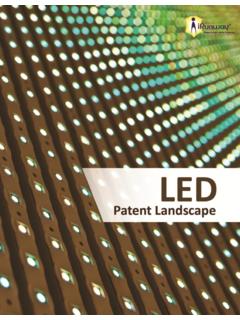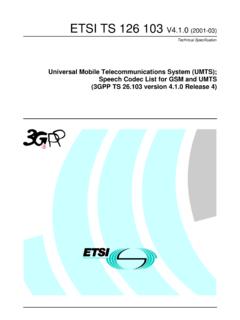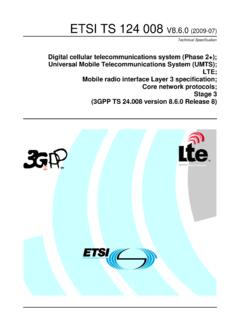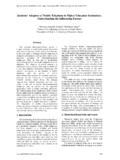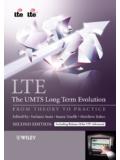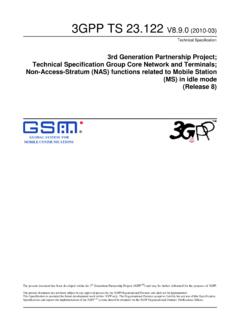Transcription of 2G & 3G Mobile Communication - iRunway
1 2G & 3G Mobile Communication iRunway 2013 Confidential Page 2 of 26 Contents 1 Executive Summary .. 3 2 Introduction .. 4 Overview of 2G & 3G Technology .. 4 Technical Highlights of 2G & 3G .. 4 Comparative Study of 2G, 3G & 4G-LTE .. 5 3 Analysis of the 2G & 3G Patent Landscape .. 7 Patent Categories & Distribution .. 7 Top Patent Holders .. 7 Analysis of Seminal Patents .. 9 Analysis of Standard-Essential Patents .. 12 Patent Filing and Grant Trends .. 14 4 Key Players in the 2G & 3G Patent Landscape .. 15 Ericsson .. 15 Nokia .. 16 Qualcomm .. 17 Alcatel-Lucent .. 18 Samsung .. 19 5 Monetization of 2G & 3G Patents .. 20 Potential Licensing & Litigation of 2G & 3G Patents .. 21 6 Glossary of Terms .. 24 2G & 3G Mobile Communication iRunway 2013 Confidential Page 3 of 26 1 Executive Summary Emerging technologies such as 4G-LTE attract the lion s share of industry and media attention.
2 However, 2G and 3G wireless networks remain highly relevant, currently supporting over 80% of all Mobile phone activity. Trends suggest the use of 2G and 3G technologies will expand dramatically during the next three to five years as the world s two largest markets, India and China, open their doors wide to Mobile phone usage. Ericsson, Nokia, Qualcomm and Alcatel-Lucent are among those who developed the building blocks of today s wireless world. They collectively control the majority of all patents in this space. Nokia, LG Electronics and Qualcomm alone own more than 43 percent of all seminal patents ( , determined to be strong based on a set of parameters). The playing field has evolved dramatically in recent years, causing these brands to slowly fade from the minds of consumers. However, they will continue to exert an influence on current market leaders such as Apple, Google and Samsung, who control today s Mobile device ecosystem.
3 2G and 3G technology patents have been at the center of ongoing patent wars and they can be expected to fuel a significant escalation in activity during the next five years as top patent holders seek to monetize their portfolios. Leading patent holders have already launched initiatives against major competitors, with some having sold patent rights to various companies. It is highly likely, given the increasing pressure on these companies to generate revenue, that many will become more aggressive by entering into new agreements with patent privateers to monetize their assets. The result will likely be an increase in litigation and licensing. So, who stands to benefit in this evolving marketplace? Which companies control the largest number of patents and the largest number of seminal patents in the world of 2G and 3G technologies? Which companies are best positioned to leverage monetization efforts?
4 These are some of the questions addressed in this report. We explore key 2G and 3G patent holders, providing details on the number and category of overall, standard-essential and seminal patents. The report delves into companies that control a large percentage of seminal and standard-essential patents. Nearly nine percent of seminal 2G and 3G patents are currently held by certain companies, and approximately five percent of all standard-essential patents are held by two companies - Innovative Sonic Ltd. and Vringo Infrastructure Inc. This report also reveals that these companies that hold key 2G and 3G patents have remarkably high patent monetization potential. 2G & 3G Mobile Communication iRunway 2013 Confidential Page 4 of 26 2 Introduction Overview of 2G & 3G Technology 2G was commercially launched in 1991. It introduced digital signaling via packet data in telecommunications, and provided reduced power consumption and noise levels.
5 It also proposed better security methods with digital encryption techniques coupled with lower power usage. SMS, MMS and e-mail were a few packet-based services introduced by 2G. Although highly advanced markets have reached a stage where 2G networks are now being switched off, 2G technologies still account for over 80 percent of connections in China and 90 percent in India - the two largest Mobile markets in the world. With successive technologies such as , and 3G, the era of ever-increasing data rate demands skyrocketed across the globe. While packet data was introduced in 2G, higher data rates and better data services were brought by 3G. Attractive services such as Mobile TV, Video on Demand, Video Conferencing, Location-Based Services and Global Positioning System (GPS) gradually grew into a necessity for a majority of Mobile users. Statistics1 suggest that, as of 2012, more than 500 operators across 185 countries have deployed 3G networks, pointing to the fact that Mobile users in more than three-quarters of the world s markets have access to 3G services.
6 Technical Highlights of 2G & 3G The 2G Advantage Lower power consumption, better security and better bandwidth usage are the key advantages of 2G over its precedent technologies. 2G introduced digital encoding in telecommunications, resulting in better compression and multiplexing of voice data than its preceding analog encoding. The advantage: 2G supported a larger number of calls in the same radio bandwidth and ensured lower power consumption that improved battery life in Mobile phones. Digital encryption methods introduced in 2G provided better security and privacy to Mobile users. Short Message Service (SMS) and Multimedia Message Service (MMS) became the first form of packet-based services introduced in 2G, marking the beginning of data services on Mobile phones. 1 2G & 3G Mobile Communication iRunway 2013 Confidential Page 5 of 26 The 3G Advantage 3G entered the market with the advantage of increased data rates available to Mobile users for services such as Mobile TV, Location-Based Services, video calls and internet browsing on the move.
7 It also provides variable data transfer speeds ranging from 128 kbps to 3 mbps depending on the speed with which the Mobile device is moving within the network. Beyond Mobile telephony, the higher speeds allowed 3G connections in PCs, gaming consoles, tablets and any other portable device that could benefit from a faster and higher-quality internet connection. 3G also provides users with better security through user authentication capabilities when communicating with other wireless devices. 3G boasts of better power control methods for both uplink and downlink, with the network using a target Signal-to-Interference Ratio (SIR) to adjust its output power. It also improves spectrum utilization through shared channels in the radio interface, thus making it more effective than 2G networks. Comparative Study of 2G, 3G & 4G-LTE 2G 3G 4G-LTE Services Introduced Data services such as text messaging (SMS), multimedia messaging (MMS), internet access & SIM cards.
8 Term Mobile broadband introduced because of its speed & capability. Universal access & portability across different device types. High definition streaming & IPV6 support. Throughput/ Speed Kbps. Mbps (peak)/ 500-700 Kbps. 100-300 Mbps (peak)/ 3-5 Mbps. Technology GSM - Global System for Mobile Communication with technological backbone of TDMA (similar to FDMA). UMTS as its core network architecture with HSPA protocol. E-UTRA (Evolved UMTS Terrestrial Radio Access) as the air interface for LTE. Additionally, uses a technology called MIMO where the modem uses two separate antennas simultaneously 2G & 3G Mobile Communication iRunway 2013 Confidential Page 6 of 26 to deliver super-fast speed. Standards GSM, GPRS ( ) & EDGE ( ). UMTS & CDMA-2000 standards. Multiple radio standards unified into a single IP network. Voice & Data Support Voice & data could not be simultaneously supported.
9 Simultaneous voice & data support. Simultaneous voice & data support at higher data rates. Switching Techniques Consists of only circuit-switched networks. Uses a combination of both circuit-switched & packet-switched networks. Uses only packet-switched networks, thus lowering latency and enhancing call quality. Frequency Band Initially 900 MHz spectrum was used, but later GSM was introduced on an 1800 MHz band. GHz. 2 8 GHz. 2G & 3G Mobile Communication iRunway 2013 Confidential Page 7 of 26 3 Analysis of the 2G & 3G Patent Landscape Patent Categories & Distribution Around 17,268 patents have been granted in the 2G and 3G domain. The following technology categories were identified based on our analysis of the patent landscape: Level 1 Categories Level 2 Categories Number of Patents Communication Quality (3840) Backhaul Network 2886 Congestion Control 577 Handover 377 Data Transfer Rate (3871) Error Control 437 Link Adaptation 304 Shared Traffic Channels 1758 Spreading Codes 942 Transmit Diversity 430 Positioning (1576) Network Based 292 User Equipment Assisted 1102 User Equipment Based 182 Power Management (1829) Continuous Packet Connectivity 1197 Power Control 632 Security (4714) Access Control 1648 Encryption 3066 Services (1438) Location-Based Services 139 Value-Added Services 1299 Table 1: Level 1 & Level 2 technology categories with number of granted patents Top Patent Holders The top companies in the 2G and 3G landscape with respect to their portfolio size are shown in Figure 1.
10 2G & 3G Mobile Communication iRunway 2013 Confidential Page 8 of 26 Figure 1: 2G & 3G Patent Distribution of Top Companies (Source: iRunway analysis based on patent data from USPTO) * The patent portfolio previously owned by Nortel Networks was acquired by Rockstar Consortium, a patent licensing company that owns and manages a portfolio of more than 4,000 patents. Table 2 shows the distribution of patents for the top companies across categories: Company Patent Distribution across Level 1 Categories Comm. Quality Data Transfer Rate Positioning Power Management Security Services Total Ericsson 274 415 94 241 269 211 1504 Nokia 213 272 163 196 381 138 1363 Qualcomm 135 230 108 211 203 28 915 Alcatel-Lucent 229 195 25 83 161 100 793 Samsung 162 299 27 37 84 44 653 AT&T 182 30 33 31 267 95 638 Research in Motion 14 72 12 24 464 12 598 LG 26 387 55 30 57 29 584 Cisco 158 2 7 14 300 7 488 InterDigital 31 300 8 88 29 6 462 Motorola Solutions 58 57 37 74 87 40 353 Nortel Networks* 114 56 32 36 73 35 346 Total 1596 2315 601 1065 2375 745 8697 Table 2: Patent distribution of top companies across Level 1 categories 1504136391579365363859858448846235334604 0080012001600No.

